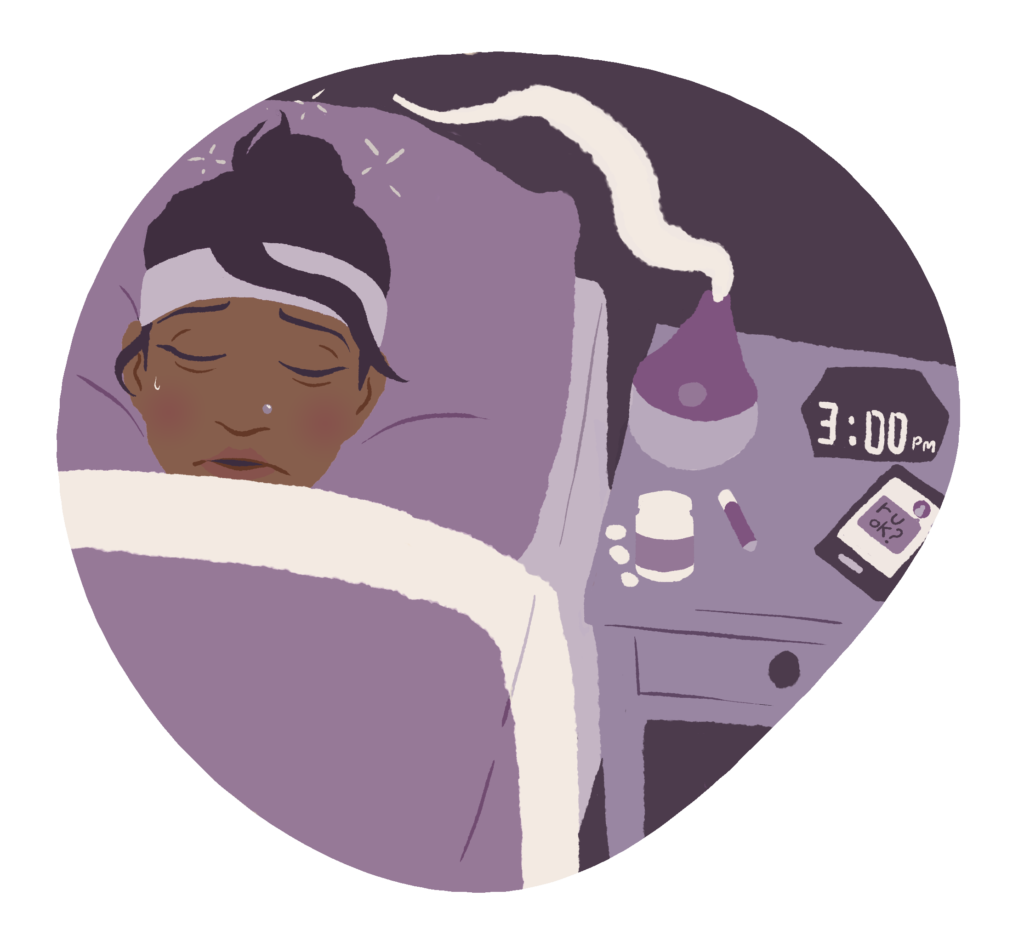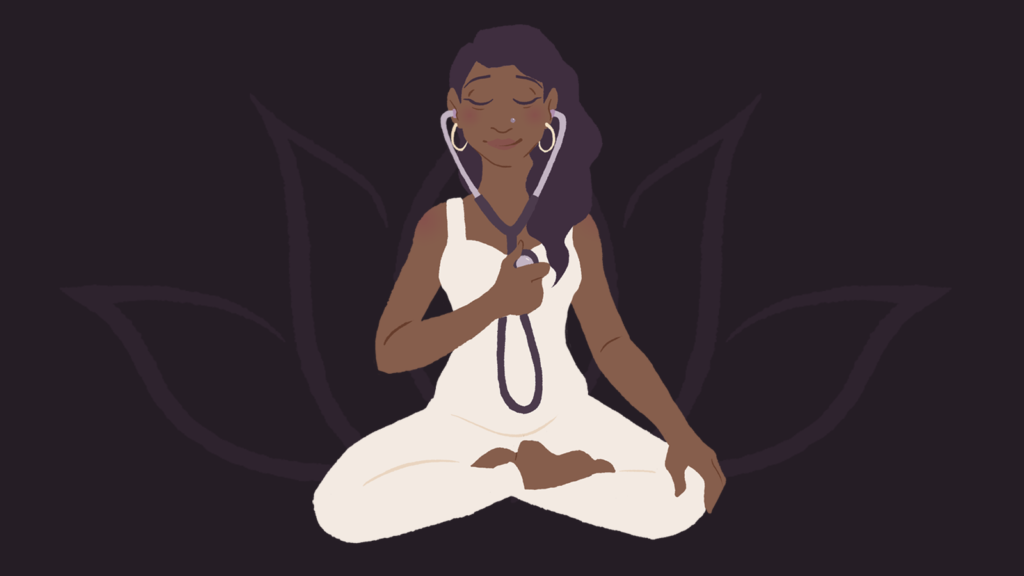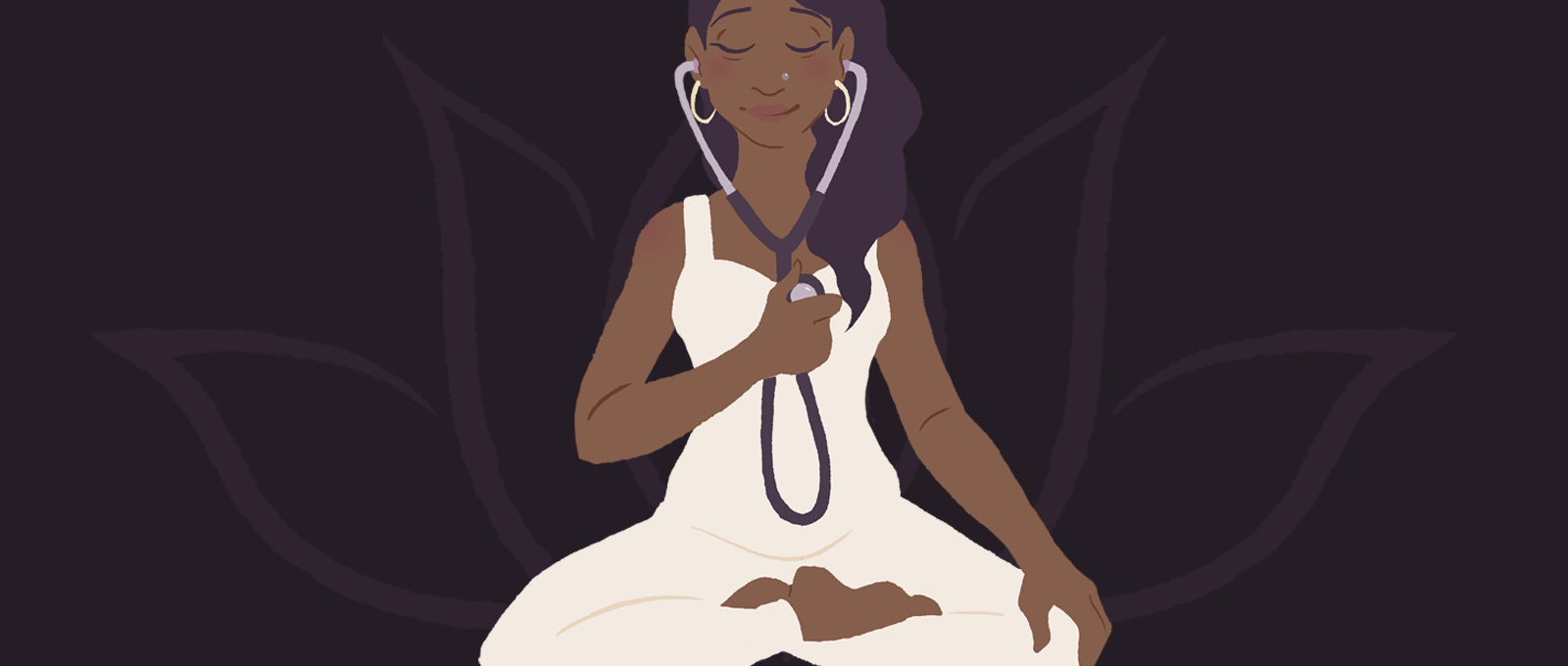Roopa is a female in her mid-thirties living with migraines for over a decade. It is a story written first-hand from her own perspective. This is her story of personal growth and on creating a life of balance to make space for managing chronic pain.
Migraines Versus Regular Headaches
At first, I didn’t realize I was experiencing migraines; I just thought they were tension headaches. I figured the stress of being a student may have brought these on.
As the headaches became more debilitating, I researched symptoms and realized they were migraines. It can be hard to know the difference – but migraines are often more severe, and have unique characteristics. Some people living with migraines experience auras (I do not!), but I do experience severe sensitivity to light and sound from the start, that take 12 to 24 hours to pass on their own. In tracking them, I realized they were also connected to my cycles – known as menstrual migraines.
How A Migraine Feels
During the migraine period itself, I experience throbbing pain in my head and a heaviness behind the eyes. I can’t focus on anything that requires concentration.

I often experience nausea alongside the pain, making my migraines more intense. More recently, I go through pre and post-symptoms (known as pro-dromal and post-dromal symptoms). Prior to a migraine attack, I have an increased sense of hunger and appetite, which, if not careful, can lead to worse nausea and the need to vomit when the migraine hits.
The day after feels like a migraine hangover – I feel groggy and still have a hard time focusing. It can be a 3 day experience (without medication). And if I’m not careful, I can relapse back into another migraine.
Managing Migraines In The Beginning of My Journey
For a long time, I was really reactive with migraine management. When a migraine hit, I’d shut everything down, crawl into bed, turn off all lights and any sound, hydrate, and wait for the migraines to pass. I had a whole kit going: an Indian product similar to Tiger Balm (called Amrutanjan), a cold compress, a humidifier, Advil liqui-gels, and a cloth to tie around my head.
Then I would attempt to sleep them off – anywhere from 12-24 hours, basically in bed.
The Impact of Migraines on My Life
It’s hard for people to understand what it’s like living with something so debilitating unless they have a chronic pain condition.
For years, I basically rearranged my life when migraines hit. Because of how unpredictable they felt, it created an inconsistent lifestyle. It was hard on people close to me too. It’s never fun for friends or family to receive last minute cancellations or for me to not be able to follow through on a commitment.
Early on in my career as an educator, I needed to clear everything in my schedule when I experienced a migraine because I couldn’t get through the day otherwise! I would cancel meetings, classes and even events. I remember attempting to teach through a migraine once, and nearly fainted at the front of a lecture hall. Not a fun scene for any of us!
In a positive way, these situations have helped me incrementally re-examine my life and health in ways that have been transformative in the long run. Because of my migraines, I’ve been forced to prioritize my wellness over the busy-ness of life and work – and to set better boundaries all around.
Realizations, Strategies and Advice to Help Me Cope

The most helpful realization for me was that migraines are connected to so many other parts of the human system. Food, sleep, stress (emotional and physical), exercise, trauma, relationships, family histories – all of these are connected.
A naturopath once shared an analogy of our bodies speaking to us quietly at first, and more loudly when we don’t listen, until sometimes they have to shout! I totally believe this, and the same can be said for our minds
Migraines became easier to manage when I focused on causes rather than symptoms – everything from food triggers to sleep, exercise, and even the company I keep (negative energy sounds out there for some, but I believe it influences us!). Physical yoga practice and pranayama (breathing exercises) have probably been the best tools for me, but there are many more!
It has been important to take care of myself physically, emotionally and mentally. Isolating migraine triggers in my diet has been helpful, having a routine and realizing that it’s not just one thing that causes chronic pain. Physical yoga practice has probably been the best single tool, but there is so much more!
The overall strategy that works for me that others may benefit from is figuring out how to live a calmer and healthier day-to-day, rather than look to escape to calm on vacations or retreats (although that is also important).
To reiterate – not just one thing causes chronic physical pain. It has been important to take care of myself physically, emotionally, and mentally.
The Many Things I Have Tried and Suggestions for Others
I’ve tried so many avenues! Here are some helpful elements:
Elimination diet: One of the first naturopaths I saw had me on an elimination diet. I cut out bread, sugar, processed foods, and inflammatory vegetables. It was tough to do at first but after the first month, my body felt better and my headaches decreased. I don’t believe in doing anything too extreme for too long, but resets do help me.
Water: I definitely drink more of it! I try to get this in early on in the day, but also find you don’t need to overhydrate – it depends on your body type.
Managing my sleep schedule: Getting enough sleep, sleep quality and being consistent with what time I go to sleep has an impact. I’ve been a night owl forever, so an early bedtime remains my biggest challenge!
Exercise and Yoga: I’m a big fan of hatha yoga practice and have been studying the practice and the philosophy for a long time. I see a strong inverse correlation between yoga and migraines – the less yoga and exercise I do, the more frequent the migraines. An at home practice a few days a week helps me relax and recharge areas of the body and mind that need it!
Ayurveda:
Ayurveda (an ancient Indian life science) has helped me understand my constitution and body. In Ayurveda, migraines are a condition closely linked to digestion. Once I realized that, I started paying more attention to what I am eating and how I am preparing my food.
Basically, Ayurveda helped me realize how important the brain-gut connection is.
Hormones: Understanding many women get menstrual migraines just before or during their cycles was an important light-bulb moment for me. Recognizing the link to hormones helped me actively manage what I could in terms of food choices to prevent or reduce higher levels of Estrogen (which cause a bigger drop pre-cycle, worsening migraines.)
Time management on computers and screens: This one is simple – the more time on a laptop or phone (let’s face it, with poor posture!), the worse for anyone! The tightness I develop in my shoulders from typing and texting can constrain nerves and also cause headaches.
Regular massages: I try and get a massage once a month. Massages are helpful to release tightness in the back and shoulders.
Vitamin Supplementation: Magnesium has helped me prevent migraines. I take an iron supplement and a vitamin B complex as well, which help with energy levels.
Communication and Creativity:
A strong community and supportive friends are so important for me. Connecting one on one especially with those on a similar wavelength, does a lot for my mental health and prevents a build up of stress that can lead to migraines. Laughter really is the best medicine!
Creative and emotional expression are also super important. Keeping ideas or worries in for too long are a recipe for trouble!
Prescription Medications:
This past year I finally started prescription medication, a Triptan called frovatriptan. I resisted medication for so long with a prevailing attitude of self-reliance and independence. As much as I believe we CAN heal ourselves in the long run, there are unexpected life stressors that happen. Along with working on my own resilience, triptans have helped me reset and get back to normal faster – within a few hours rather than a few days!
The one immediate downside to the form I take is that they make you drowsy; I need a nap before I can operate again, but this is a small cost compared to what I used to go through. I’m also trying not to be dependent – I try to limit intake to when I really need them.
General Advice From One Migraine Sufferer To Another
- Have patience and try things! We are often toughest on our own bodies or minds and we are a lot gentler with our family and friends. It takes time to experiment and understand your triggers.
- Develop empathy and confidence in yourself: not everyone can or will empathize with what you are going through, so make sure you are your biggest and best advocate. Discover what makes the most sense for your health, and follow those principles! The boundaries you set to be healthy are important.
- Re-consider your diet: There are common triggers (dairy, sugar, caffeine) and other not-so common ones to cut out of your diet to reduce migraine attacks. Do some research and experiment with your diet.
- Seek professional help or alternative therapies that resonate with you: everything from acupuncture to psychotherapy have helped other migraine sufferers.
- Keep a migraine journal: Track when you get a migraine, and note what you ate the day or two prior, your sleep patterns, any stressors, connections to your cycle etc. This is helpful for you and for professionals you deal with to identify and eliminate triggers.
- Don’t give up!: It really is a battle for the long run – so when you falter or get into a rough patch, just start again! You will get back to your center easier overtime.
Were I Am Now in My Journey
I still tend to get a monthly migraine, but they are not as frequent or debilitating as before. Along with the natural suggestions I have, prescription medication really has helped me regain a sense of consistency.
I’m at a much stronger place in this journey than when I felt helpless years ago. I feel more in control because I am aware of my triggers, and I have a wide range of tools to help me. I’m also more confident and able to own my responsibilities, while saying no to commitments that push me over my capacity.
I have also shifted to a more proactive approach – getting in light exercise more often, not allowing days straight of intense screen time, eating on time, solid catch ups with close friends each week. I’m not as strict with my diet these days, but I’m a lot more conscious and careful with where I spend my mental and emotional energy. Realizing you have control over how you spend your energy is a really good feeling!
The most important part of my current process is this: Accepting where I am at and listening to my body – this isn’t always the same day to day. I have put a lot of work into re-wiring harmful tendencies in different areas. It is still a process, and I wish others on this journey all the very best in their processes, too!
Authors:
Roopa (last name not added for confidentiality)
Graphics/Illustrations: Larrisa Darrah
Edited and Reviewed by The Health Aisle Team



Leave a Comment